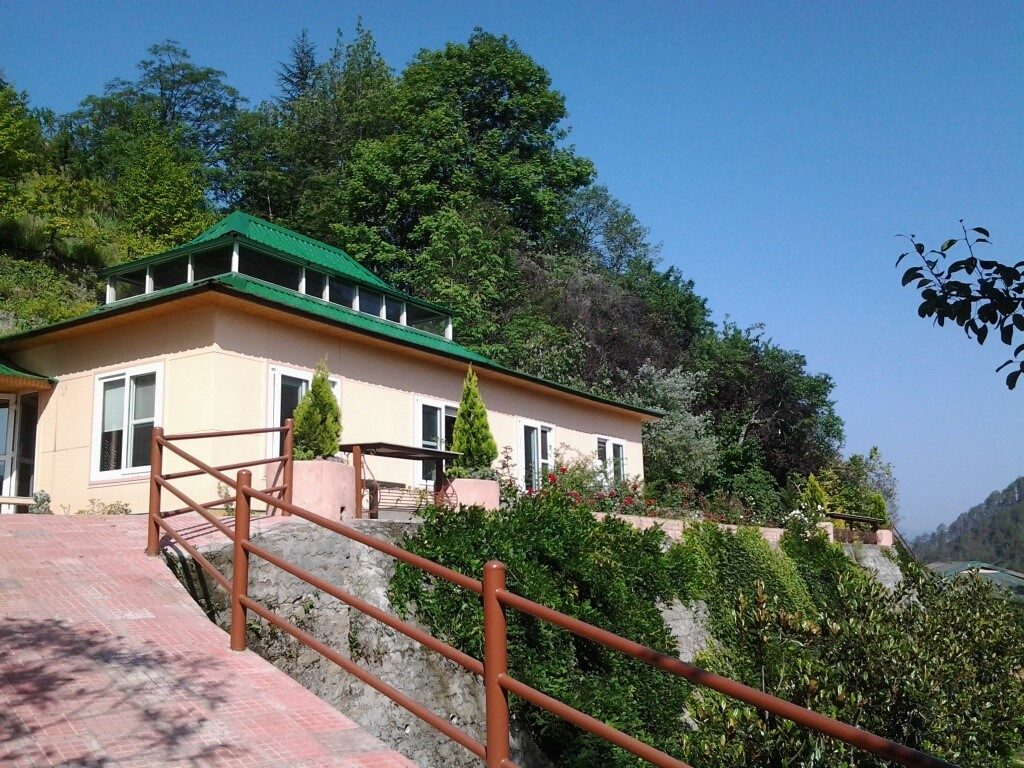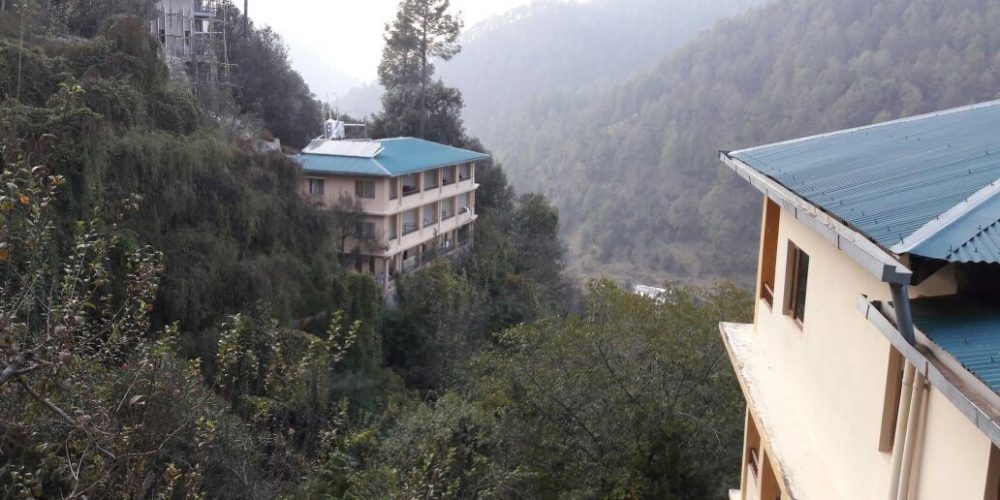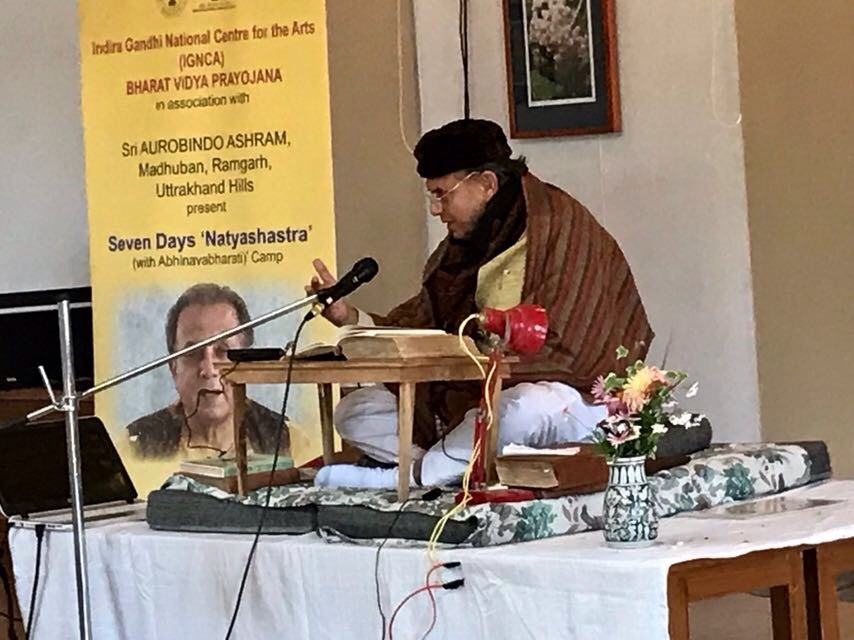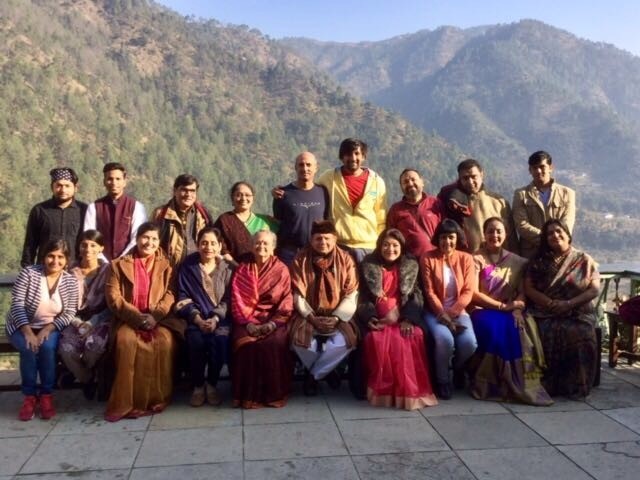While our Shastras continue to be ignored at home and even ridiculed by the left liberals, some of our age old theories are being packaged as new thoughts of the millennium. David Mamet, the iconic American playwright-screenwriter-director, has propounded what he refers to as, ‘The unified field theory of aesthetics’. This theory may sound esoteric to the American students (including MITians) but it is not new to Indians.
Bharata Muni had given India it unified aesthetics theory some 2,500 years ago. The Natyashastra had laid down common principles of aesthetics for all arts. The principles for making an aesthetically pleasing spoon could be applied to drama and vice versa. The tenets of Natyashastra were equally relevant to the useful arts and the fine arts. Unfortunately this great text is now limited to conferences and a small academic circle.

An idyllic setting in Ramgarh in Uttarkhand where Prof Gupt conducted a traditional style vyaakhayaa on Natyashastra
Indra Gandhi National Centre for the Arts and Aurobindo Ashram had recently organized a week-long lecture series, ‘Natyashastra with Abhinavabhaartii’, by an eminent Classicist and Natyashastra scholar of our times, Prof Bharat Gupt. Not only was Ramgarh in Uttarkhand an idyllic setting for studying an ancient text, but Dr Gupt made it even more authentic by conducting the whole series in the traditional style. Most scholars take a western approach to analyze and lecture on the ancient texts, which means a lecture followed by a quick Q & A. However, Prof Gupt went with the traditional style vyaakhayaa. In the traditional Indian method the speaker reads the text in Sanskrit, translates it, puts forth the commentaries on the text and then relates it to the modern practice. This traditional approach preserves the wholeness of the text. The Western approach fragments the text and the audience does not get a complete overview. Indian arts needs to be seen in the context of history, culture, social relations, social makeup and political background. It cannot be seen in isolation. In Abhinavagupta’s words a great scholar should look at the text like a man sees an olive in his palm. “Hastaamalaka’ is the metaphor for seeing the Shaastra in totality. Prof Gupt did just that through his vyaakhyaa.
It was impossible to discuss all the 6,000 kaarikaas given in the 36 chapters of Natyashastra in the given time of 7 days in thirty hours, therefore only the essential kaarikaas were discussed in detail. Kaarikaa is a shloka that executes meaning. For starters Prof Gupt demolished the major controversy around the date of Natyashastra. He cited evidence to prove Natyashastra was written in the fifth century BC, and not the second century AD as claimed by the Western scholars. The most crucial evidence being that Bharata Muni lived before Panini, the Sanskrit grammarian, who is estimated to have lived around 520 BC. Further, sage Valmiki has used Natyashastra’s vocabulary in Ramayana, which proves that Bharata Muni existed at a time before Valmiki. The dating of Natyashastra is significant because it implies that Aristotle’s Poetics was written at a much later date compared to Natyashastra. In which case, there’s a possibility that Aristotle borrowed from Natyashastra and not vice versa. Unlike Poetics, Natyashastra was not written by one person. Indian texts were written by a group of scholars over a long period of time. Bharata Muni had compiled it from earlier texts and his hundred disciples expanded the Natyashastra.
The story of the origin of Natyashastra is just as interesting. The legend goes that in the Treta yuga, when sattva was declining and there was a mix of happiness and unhappiness, Indra asked Brahma to create a ‘play’ or activity to please the mind through the aural and the visual senses. Also, the pleasure that Indra was seeking was not the sensory pleasure, but a pleasure of the elevated kind. Indra emphasized the need for knowledge for the illiterate persons who had no knowledge of the Vedas.
Hence, Lord Brahma created the Natyaveda and instructed Bharata Muni to create the Natyashastra for the art of natya or theatre. Bharata Muni borrowed the text or ‘path’ from Rig Veda, music from Sam Veda, abhinaya from Yajur Veda and the concept of rasa from Ayurveda. Prof Gupt expanded on the relationship between Ayurveda and natya. He said natya acts as a medicine and restores balance in the human body. It brings you back to a state of emotional balance which was distorted due to worldly tribulations. It should be noted that Natya had an elevated status in ancient India.
Amrtamanthan, the first play created and staged by Bharata Muni, has also been a subject of controversy. The play and its theme have been wrongly interpreted by the scholars as a fight between the Aryan and the Dravidian races. Prof Gupt is of the view that the conflict between the devas and the asuras should be seen as the conflict of values and not interpreted in historic and anthropological terms.
One by one all the conflicts around Natyashastra were taken up and resolved. Talking of the theater halls, Prof Gupt said, that on the one hand there is detailed description of natyagrihas/theater halls, but on the other we find no archaeological remains of the theater halls. In contrast, remains of Greek theaters can be found not only in Greece but also as far as Afghanistan. Prof Gupt explained that the natyagrihas were temporary structures and were dismantled at the end of the play. Just like there are no remains of the thousands of ancient Yagyasthalas, there are no remains of the natyagrihas. Even stage props were ‘pusta’ or fragile and temporary. Further, he gave the example of the modern-day Hindu Wedding mandap. Even today for every wedding the mandap is erected and dismantled after the wedding.
Unlike today the audience of ancient India was not fragmented and the art was accessible to everyone. There was no rural-urban divide, the same plays were enjoyed by the elite and the common man. In fact, Natya bridged the distance between the rulers and the ordinary citizens. The king or the rich patron along with the residents of the town/village participated in the yagya and the construction of the natyagrah. Hence from the construction of the theater hall to the last day of the performance, theater was a community affair. Theater was funded by the rich patrons, the community and the temples. Theater did not depend on the royal patronage only, hence theater was not liable to censor or follow political correctness. Natya performances happened throughout the year. There were multiple productions in a town. Hence many natyagrihas had to be constructed and there may have been multiple patrons. If we had to conjure the image of ancient India, by the description given in the Natyashastra, it would appear to the modern eye as a colourful, festive place that came alive every evening with dance, music and theatrical performances.
Another distinct feature of the ancient Indian theater was the emphasis on gesture, dance and body movement. Prof Gupt emphasized the difference by calling Western theater, ‘the theater of dialogue’. He said in Indian theater, body was the main medium of storytelling. Abhinaya has four parts – aangika (body), vaacika (dialogue), saattvika (emotions) and aaharya (costume). According to the Indian aesthetic theory, verbal language is incapable of depicting the cosmos, hence it is just one of the abhinayas.
What with shrinking attention span, there’s a trend to produce plays with a running time under two hours. Compare the modern trend with the ancient theater where even the prelude to the play was two hours long. Puurvaranga or the prelude had a set sequence of music, dance, singing, prayer and jest. While an elaborate puurvaranga was performed at the start of the play, a short puurvaranga was performed every day. This means a full-length play such as Abhijnanashaakuntalam could not have been performed in one day. Prof Gupt concluded that only one act could have been performed in a day and a seven-act-play would have been performed over eight to ten days.
The interrelation between natya, nrtta and sculpture is a fine example of the unified aesthetics theory in ancient India. Natyashastra talks about pindi bandha, which were part of the puurvaranga. Pindi bandhas were specific postures to depict a devata, for instance samapaada posture depicts Vishnu. Later pindi bandhas became prototype for sculptures and temple icons. Prof Gupt emphasized that all the icons in temples are dance icons and the origin of sculpture is in natya karanas or Nrtta.
Natyashastra is not limited to theater craft and aesthetic principles. The rasa siddhanta, which is the foundation of the Indian aesthetics theory, goes deep into the psychology of drama and the psyche of the spectator. Rasa siddhanta is unique to Indian aesthetics theory. The literal meaning of rasa is juice. According to Bharata Muni rasa is extracted from the other ten elements of drama. Bharata Muni says there’s no meaning without rasa. Bharata Muni was clear about what was acceptable as art. He says only those arts that are worthy, are rasa vishesh. Not every kind of rasa is suitable for attainment of dharma, artha, kama, and moksha. Hence art that merely entertains, gives lowly pleasure or titillates is not capable of rasa. It gives the impression of rasabhaas – rasa ka abhaas. But it is not socially, mentally healthy. For instance porn. Only that which has asvaadyatva (worthiness of tasting) is rasa.
Bharata Muni has drawn a parallel between drama and food to explain the concept of rasa. He says when an open-minded spectator sees acting which is embellished with different bhavas, gestures and acting, the spectator experiences joy just as a person experiences joy on eating a dish which has been flavoured with spices and condiments. Prof Gupt emphasized the spectator does not create rasa, he is suffused in it.
Prof Gupt was categorical there are only eight rasas in Natyashastra. Some students put forth the ninth rasa, which is referred to as shaanta rasa. Prof Gupt said Bharat Muni did not add shaanta rasa to the list because shaanta rasa and its originator sthayi bhava (nirveda/vairagya), cannot be enacted in detail on stage.
Closely related to the concept of rasa is vibhaava. Bharata Muni says vibhaava is that which expands the meaning by using the techniques of theater such as abhinaya. The root word for bhava is bhu. If you burn an incense stick, its aroma pervades. This is bhaavayan. Likewise an actor has to pervade the audience. He has to affect the audience. Bharata explains that actor is the vibhaava and he takes up the bhaava and the meaning. Through gestures and acting the audience infers the meaning. These gestures are anubhava. Bhaava (thoughts plus feelings) is carried by vibhaava and deciphered through anubhavas.
Bharata Muni says that just as fire pervades the dry wood and the whole forest starts burning, likewise the intent or the meaning pervades the body of the actor and reaches the spectators and all the spectators are affected. This bhaava expansion is the cause of rasa.
Prof Gupt discussed the commentary of the four great commentators on the rasa sutra – Lollata, Sankuka, Bhattanayak, and Abhinavagupta.
Abhinavagupta uses the analogy of the deer chase in Abhijnanashakuntalam to analyze rasa sutra. He explains that on seeing the deer chase the spectator feels no anxiety for the deer because there is no earthly reality of what is being seen. Neither the deer, nor the chaser are real. The self of the spectator is neither assertive, nor subdued. Since dramatic emotion is impersonal it is felt in a special way. In drama we can step away from personal. Further Abhinavagupta says, that the experience of a single spectator is influenced by the community of spectators. When the community of spectators is offered the same pratiti, the resultant experience (sadharanikarana) is so strong. This single unifying experience which is deeply felt by the audience is rasa.
Prof Gupt put forth his own analysis of the sutra. He said rasa is not just in transformation of sthaayii bhaavas but in the union of sthaayii with anubhaava, vibhaava, and sanchaarii. The union of vibhaava, anubhaava, and sanchaarii bhavas forces the spectator to forget everything. It is then that the spectator is in total tanmayataa with the natya and this complete union (samyukti) is rasa. Prof Gupt says that rasa is extreme extroversion, going out of yourself to unite with the prayoga.
Last of all, Prof Gupt examined the position of rasa in Marxist theory. He said the followers of Karl Marx believe that rasa is dangerous because it causes escape. To them the purpose of theater is revolution, not escape or aesthetic beauty or rasa.
Coming to the application of rasa siddhaanta to other arts, Prof Gupt explained the principles and definitions of rasa given in Natyashastra will not apply in the same way to other arts and media. There has to be a different grammar and definition for other arts. For instance in a painting the balance of colours results in rasa. Rasa and bliss are synonyms in one sense, but not every sense. Prof Gupt emphasized that rasa is not bound by time. Bharata Muni’s rasa concept is not only for ancient plays, it can be applied to modern plays as well. Notion of beauty may change but the end result or rasa is the same. Most scholars dispute that Aristotle has called ‘Katharsis’ as the purpose of drama. Prof Gupt criticized scholars for having read the Poetics in parts. Because Aristotle has said that we go to watch a play for ‘proper pleasure’. The word for ‘pleasure’ is ‘Hedone’. Katharsis is one of the things that emerges watching tragedy, but not the main thing. ‘Pleasure proper’ to that genre of performance, that is tragedy/comedy/satirikon, is what we seek. Proper pleasure to a tragic play is tragedy and likewise for comedy and satirikon.
Prof Gupt said that looking at all the vyakhyas and analysis we can conclude that pleasure is the primary cause of seeking art.
In the context of rural theater, Prof Gupt remarked that the sophistication of ancient Indian theater has been lost for 900 years. Remnants of traditional drama survive in dance forms like ‘bhavai’ and ‘koodiyatam’ etc. There was a constant flow, travel and exchange of artists and manuscripts between the rural and the urban India. There were educational institutions even in small villages. Theater had multiple patrons and companies toured the production all over the country. Hence rural theater was as sophisticated as city theatre. After Turkish invasion in the 11th century theatre could not be performed in the openly cities as Islamic rulers did not permit it.
Prof Gupt busted the biggest myth around ancient Indian theater. He said Indian theater is wrongly referred to as ‘Sanskrit theater’. Sanskrit was one of the many languages spoken in the ancient plays. The plays were multi-lingual. Only 20 to 30% lines were in Sanskrit. Most characters spoke Praakrta languages like Avanti, Maaghdii, Sharaseni etc. Natyashastra clearly lays down rules for who will speak which language with whom. For instance Devas spoke Ati Bhasha or old Sanskrit, the kings spoke mostly in Sanskrit and illiterate and poor people spoke in Praakrta languages. There is an exhaustive list of people and the languages they would speak in which situation.
Natyashastra deals in every aspect of theater. From toe and eyebrow movements to music to musical instruments to actor’s make up to costumes to character delineation to the director’s job, Natyashastra discusses everything in great detail. It is evident that the ancient drama was a highly sophisticated art form and the audience was well versed with the language of the theater. Looking at Natyashastra we can only imagine the richness of art forms at that time.
Disclaimer: The opinions expressed within this article are the personal opinions of the author. IndiaFacts does not assume any responsibility or liability for the accuracy, completeness, suitability, or validity of any information in this article.
Rashma N. Kalsie is an Indian writer-playwright based in Australia. She is the founder of Indian Diaspora Dramatics Association. Rashma’s work besides novels and plays includes the plays Padma Shri Prahasana (India Habitat Centre, Delhi), Melbourne Talam (Southbank Theater followed by seven city tour of regional Victoria, Australia). She is currently a research associate at Vision India Foundation, New Delhi.



